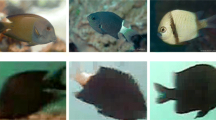Abstract
Most questions in the Fish4Knowledge project are related to the ability to count fish, fish species or events using video analysis Chap. 2. Automatic video analysis however brings uncertainty due to False Positive/False Negative classifications, which makes determining the counts based on automatic video analysis difficult. Automatic video analysis software is often able to express a measure of uncertainty for a single detection/recognition using a similarity score, indicating how certain the software is about a single decision. Logistic Regression allows us to combine these similarity scores to compute an estimated count, outperforming the estimates of the underlying machine learning methods used for the original video analysis. We show this works both for the two-class and multi-class problem. Furthermore, we identify potential pitfalls where ensuring a correct sampling procedure is essential. The error in the estimated species counts using Logistic Regression was on average around 15 on a set of 11,585 fish images, while the machine methods had an average error of 800. The key to understanding this huge improvement in accuracy is that we use Logistic Regression over the individual classifications to estimate the size of the whole population, rather than the species classification of any individual observation.
Access this chapter
Tax calculation will be finalised at checkout
Purchases are for personal use only
Similar content being viewed by others
Notes
- 1.
In our experiments, we observed that both the logit kernel, described here, and the probit kernel (Bliss 1934) obtain almost similar results.
References
Bliss, C. 1934. The method of probits. Science 79(2037): 38–39.
Chan, A. B., Z.-S. Liang., and N. Vasconcelos. 2008. Privacy preserving crowd monitoring: Counting people without people models or tracking. In IEEE conference on computer vision and pattern recognition, 2008. CVPR 2008, 1–7. New York: IEEE.
Hay, A. 1988. The derivation of global estimates from a confusion matrix. International Journal of Remote Sensing 9(8): 1395–1398.
Huang, P.X., B.J. Boom, and R.B. Fisher. 2014. GMM improves the reject option in hierarchical classification for fish recognition. In Proceedings of the workshop on applications of computer vision 2014: 371–376.
Jupp, D.L.B. 1989. The stability of global estimates from confusion matrices. International Journal of Remote Sensing 10(9): 1563–1569.
Lemeshow, S., and D.W. Hosmer. 1982. A review of goodness of fit statistics for use in the development of logistic regression models. American Journal of Epidemiology 115(1): 92–106.
Lempitsky, V. S., and A. Zisserman. 2010. Learning to count objects in images. In NIPS, vol. 1, p. 2.
Lip, C., and D. Ramli. 2012. Comparative study on feature, score and decision level fusion schemes for robust multibiometric systems. In Frontiers in computer education, vol. 133, ed. S. Sambath, and E. Zhu, 941–948., Advances in Intelligent and Soft Computing Springer: Berlin.
Platt, J.C. 1999. Probabilistic outputs for support vector machines and comparisons to regularized likelihood methods. In Advances in large margin classifiers. Citeseer.
Saerens, M., P. Latinne, and C. Decaestecker. 2002. Adjusting the outputs of a classifier to new a priori probabilities: a simple procedure. Neural Computation 14(1): 21–41.
Vucetic, S., and Z. Obradovic, 2001. Classification on data with biased class distribution. In Machine learning: ECML 2001, 527–538. Heidelberg: Springer.
Author information
Authors and Affiliations
Corresponding author
Editor information
Editors and Affiliations
Rights and permissions
Copyright information
© 2016 Springer International Publishing Switzerland
About this chapter
Cite this chapter
Boom, B.J. (2016). Counting on Uncertainty: Obtaining Fish Counts from Machine Learning Decisions. In: Fisher, R., Chen-Burger, YH., Giordano, D., Hardman, L., Lin, FP. (eds) Fish4Knowledge: Collecting and Analyzing Massive Coral Reef Fish Video Data. Intelligent Systems Reference Library, vol 104. Springer, Cham. https://doi.org/10.1007/978-3-319-30208-9_15
Download citation
DOI: https://doi.org/10.1007/978-3-319-30208-9_15
Published:
Publisher Name: Springer, Cham
Print ISBN: 978-3-319-30206-5
Online ISBN: 978-3-319-30208-9
eBook Packages: EngineeringEngineering (R0)




